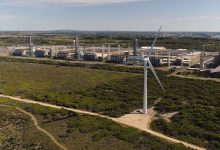CE Oltenia’s Restructuring Plan, Another Via Dolorosa?
Polluting emissions are some sort of Via Dolorosa for CE Oltenia, given that each year the company must pay tens of millions of RON because it operates and, therefore, it pollutes. Annually, depending on the amount of electricity produced, the company must purchase up to 16 million allowances, whose cost can reach RON 50-60mln, depending on the quotation of allowances on the European market. Moreover, almost half of company’s total expenses are those with the acquisition of CO2 allowances.
Currently, the company has an ambitious restructuring plan, worth EUR 3.54bn.
If we don’t privatize, we close. If we don’t close, we modernize. If we don’t do anything, we give some money to the budget to save inefficient units. But all according to a strategy, which we never get to apply. This is how we could summarize, maybe in a cynical way, the everlasting plan of the Government of Romania, irrespective of the political colour or ideological orientation, to make Complexul Energetic (CE) Oltenia, the largest coal-fired energy producer in Romania, competitive and viable in a domestic energy market misconfigured for 20 years. In fact, in Romania, the term ‘restructuring’ was used so often that it lost its meaning. As the terms ‘anticorruption’ or ‘development’. No matter how many attempts the Romanian state has to make its companies viable, they are doomed to an almost inevitable failure. That’s also because, in fact, remediation did not necessarily mean something good for a state-owned company, but only ensuring the electoral support for political formations. CE Oltenia has never been an exception, because the votes of almost 13,000 employees and their families cannot be ignored, right? But remediation did not fail only for political reasons. In fact, the main problem created by the political class and remaining unsolved so far is how the Romanian electricity production market is structured.
The error made by the Government in 2000, when it split the energy giant Conel into companies has never been repaired, although there have been opportunities in this respect. Let’s recall that in 2000 several companies were split from Conel, separated on types of activities and types of fuels. Therefore, Termoelectrica took over the coal-, heavy fuel- and gas-fired power plants, Hidroelectrica took over the hydropower plants, Nuclearelectrica remained with (then) the only nuclear reactor at the Cernavoda power plant, Electrica took over the power distribution networks and Transelectrica remained with the high voltage lines for power transmission. In the meantime, in 2007, integration with the EU with its unbundling and competition rules took place, and direct intervention by the state in this market, to repair the error from 2000, couldn’t be made in a discretionary manner, like before 2007. But there wasn’t even an attempt. And this was another issue.
The Romanian state is the majority owner of conventional power producers, namely Hidroelectrica, CE Oltenia and Nuclearelectrica, of the power transmission operator Transelectrica and of the last energy distribution companies that haven’t been privatized, all under the umbrella of Electrica brand. This is the image of the Romanian energy production sector, and the single-fuel structure is its main shortcoming.
While the major energy groups, with which the Romanian producers are supposed to be in competition in an energy market that tends to full integration at European Union level, have constantly diversified their activities and energy production sources, Romanian producers have each remained dependent on their single energy source. Although there have been attempts to regroup these companies into new commercial structures with diversified energy sources, they were never taken seriously – and this is seen by the fact that such restructuring did not actually exist – not even by the initiators. In turn, there was a preference for political control, plundering these companies through dubious sinecures and doubtful daily allowances and their use for political purposes, not infrequently with a scent of criminal offenses.
But there is another reason why each Government and each Economy or Energy Minister is so concerned with mining regions, as is the one in which CE Oltenia is located: the fear of social revolts. There is a history of the use of mining as a political weapon in the miners’ rampage cases in the 1990s, which resulted in material destruction, injuries and deaths, and a social discontent that justice ignores.
If the Government wants to truly restructure the sector, it should start with reorganization (yes, we all hate this word) of these single-fuel energy producers. While the European Union puts increasing pressure to drop the use of coal, Romania continues to allocate money for mining exploitations without future and make from their closure/opening a sinister political game, depending on who has the power at one time or another. At least in the case of CE Oltenia, if such real restructuring had been made, it wouldn’t be necessary now, right? However, this is happening and the company has a new restructuring plan.
This latest restructuring plan of CE Oltenia, from a number of similar plans not materialized in reality, is worth EUR 3.54bn. It is definitely one of the most ambitious restructuring plans of the mining giant, but the risk to be only an electoral stake – Romania has two rounds of elections in 2020, local and parliamentary – is quite high. If we look further, the image of a new plan doomed to failure becomes clearer: according to the Government, financing this restructuring program will be ensured with EUR 1.5bn from company’s revenues, and the difference will be allocated either from the state budget or from the Modernization Fund managed by the Ministry of Economy, Energy and Business Environment, an institution that owns a 77.15% stake in the coal and power producer based in Targu Jiu, Gorj County.
Beyond political reasons, this restructuring plan is also reasoned by an obligation: returning a rescue aid of RON 1.2bn, contracted by the company in February this year. The equation is simple: CE Oltenia must either return this amount or undergo restructuring. Given that in 2019 the company posted losses of RON 860mln, returning the money becomes at least unlikely. And if we also consider that in 2018 CE Oltenia’s losses amounted to RON 1.13bn, preparing a so-called restructuring plan becomes the only option. Otherwise, the Government should submit to the European Commission a plan for CE Oltenia’s winding-up, which would be both an economic and political, but especially a social drama. At the same time, 20% of the electricity available would disappear from the national energy mix, which would put the economy in the extremely difficult position of not having enough electricity to operate normally, especially that Romania does not have backup units, and energy imports are already made close to the maximum physical capacity of energy transmission networks.
This latest restructuring plan of CE Oltenia provides for the phasing out of coal and switching to renewable energy and natural gas, i.e. the diversification of energy sources needed by all Romanian electricity producers. The provisions of this plan would be applied from 2021 to 2026 and, even if the company continues to use coal to generate electricity, even after 2030, year considered by Brussels the reference for entry in a new energy era, greener and less polluting, in the long run its share will drop significantly. Specifically, the company plans to replace half of the energy it currently produces from coal with other sources.
This plan also includes projects for the investment in new production units, with a total installed capacity of 2,000 MW. For the sake of enumeration, we recall the projects that Oltenia Energy Complex says its wants to implement: 8 photovoltaic parks in Turceni, Rovinari and Isalnita, with a total installed capacity of 700 MW, rehabilitation of a small hydro-power station of 10 MW in Turceni, construction of gas-fired power plants with a total installed power of 1,300 MW in Turceni and Isalnita. According to official statements, all these investments will be made in parallel with the staged closure of certain production capacities and mining exploitations, as well as with the outsourcing of some activities. The goal is that, at the end of all these efforts, CE Oltenia gives up the production of energy from a single source, lignite, and gets closer to what the European energy companies have been doing for a long time now, meaning to have a mix of resources – coal, natural gas, green energy – and thus reduce their CO2 emissions by 38%.
As already stated, CE Oltenia is no stranger to attempts to diversify activity. Unfortunately, each time it got stuck in the phase of their implementation. But that’s also because almost always the company’s management was too close or too controlled by the political leadership of the country, which has often meant divergent objectives regarding the company’s destiny. In 2013, the company took over the assets of a hydrocarbon-fuelled power plant in Braila, in account of debt of RON 30mln. Of course, the 437 MW power plant taken over by CE Oltenia has never worked, and how the transaction was made has raised the suspicions of the Court of Auditors, which conducted an investigation.
In the end, if there is an actual desire for this company to survive and be restructured, CE Oltenia management and the Government should keep their eyes on 2050, year when the EU aims, under the Green Deal treaty, to reach the point of neutrality in terms of polluting emissions. For CE Oltenia, the efficiency of the current restructuring plan is crucial. A potential failure would also mark the disappearance of the company from the national energy landscape.
But CE Oltenia isn’t the only energy producer controlled by the state that aims high (forced to do so). Other RON 26bn would be invested in Hidroelectrica by 2025, in several other projects, such as onshore and offshore wind farms, photovoltaic parks, biomass-fired power production, hydrogen production by hydrolysis, development of e-mobility networks. If the last two projects are as topical and eco-friendly as possible, the first two are déjà vu. The company has announced similar plans several times over the past few years, but without materializing them.
Romania was always good in making plans for the future. Besides this ambitious plan of CE Oltenia, PM Ludovic Orban raised with an even more daring plan, in two directions: investments of EUR 40bn in the transport infrastructure, sector in which Romania has huge shortcomings compared to any EU Member State, and other EUR 25bn in energy. All these huge investments would take place in the following ten years. But, as mentioned, Romania’s plans in terms of energy are some of the most ambitious. By the way, Romania has set the most ambitious target in terms of renewable energy in the entire EU: 30.7% of consumption in 2030. Energy consumers hope they will not be the ones to pay the gross of this unjustified ambition, as it happened with the wind boom in 2011-2013, when Romania granted the largest subsidies in the EU for wind energy, a generosity that set the energy bills of citizens on fire.







